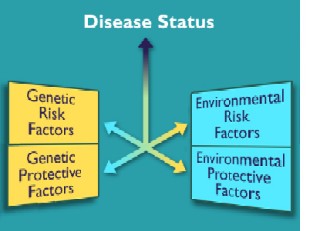
When a body cell needs a new protein, a corresponding blueprint first has to be read. The information thereto is stored in the corresponding genes.
Occasionally the blueprint is altered due to external influences. That may imply small changes in which only a single gene letter has been exchanged, or whole segments of the building instructions may be missing.
The consequences of such changes: the protein may be either not produced at all or it may be defectively assembled, so that it is no longer functioning properly.
Often there are safety precautions with which the human body can "iron out" the error again. In this case the error in a single protein does not initially lead to an illness. The illness develops only when several genes are altered and this is perhaps accompanied by damaging environmental influences (e.g. radiation, etc.) or certain lifestyle habits (e.g. smoking, unhealthy diet, etc.).
 |
|
In medical terminology such diseases are therefore called "complex diseases". Complex because there may be five or ten genes that play a role in the disease - plus environment factors and behavior, so there is not only one cause. Cancer, allergies, high blood pressure and Alzheimer’s – all of these well-known afflictions belong to that group.
To complicate this still further: in different people a seemingly similar disease can be triggered by different combinations of genetic mutations and environmental factors. For instance, in one person an unhealthy diet and a gene defect can lead to hypertension, whereas in another hypertension patient perhaps quite another gene and everyday stress trigger the disease. That is why it is so difficult to find out what is causing this disease. That is probably also the reason why until now only twenty percent of the approximately 30,000 known diseases can be treated with drugs. Only when the cause of a disease is known is it possible to develop a tailor-made therapy for it. If the cause is not known, then one must try to develop the corresponding medications by trial and error, a method that frequently is accompanied by undesirable side effects.
With the aid of systematic genome research it is now possible to find new points of attack for drugs. To begin with, researchers are comparing diseased and healthy tissue and are searching for proteins that function differently or are present in greater quantities in an ill patient than in a healthy individual. They then attempt to construct an agent that activates or blocks the altered protein.
Page 2: Why drugs sometimes have side effects or have no effect at all.




